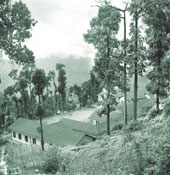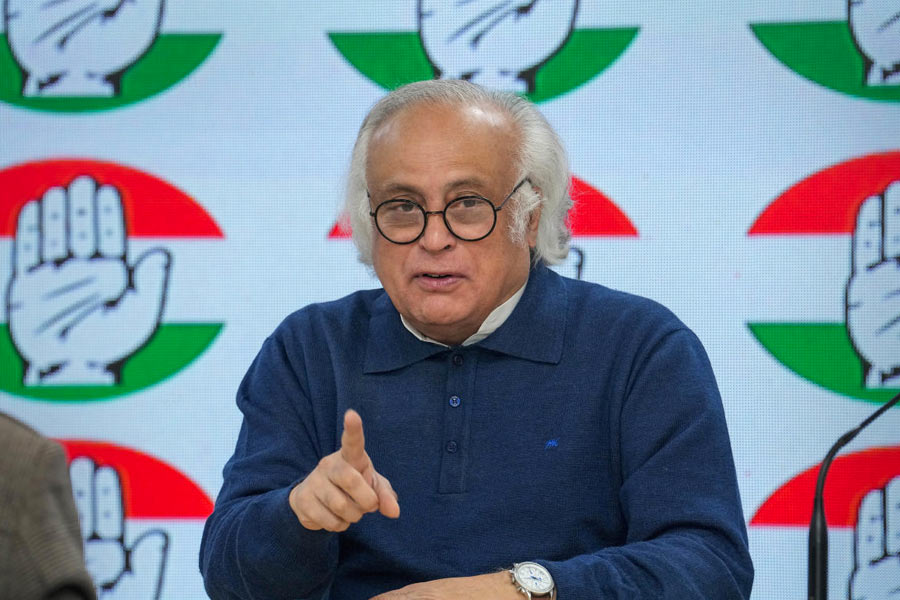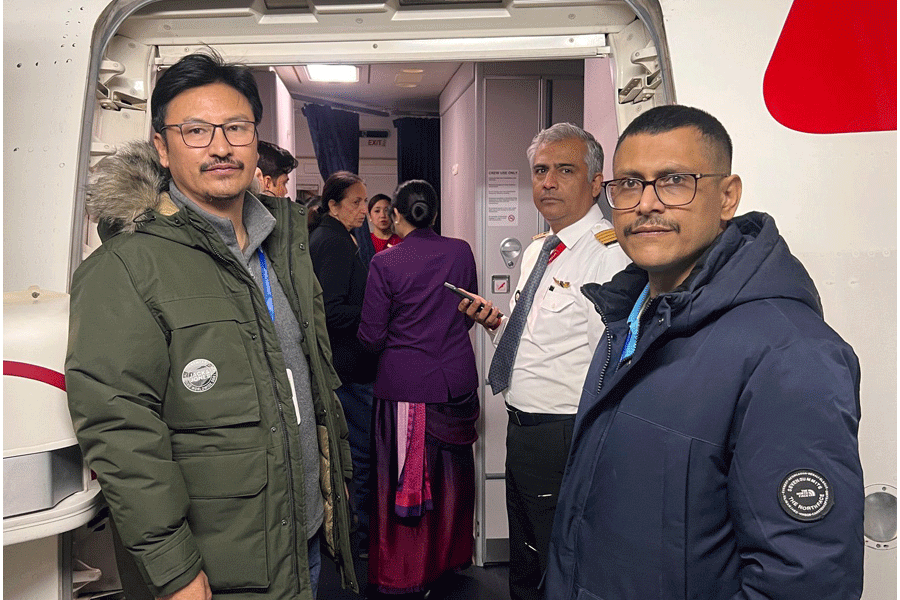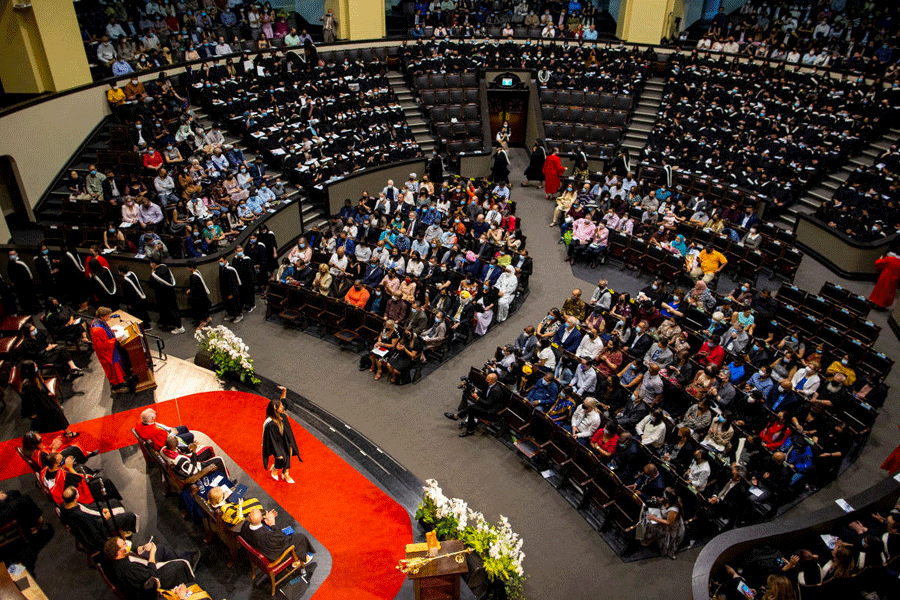 |
| lost inheritance: A hilltop view of Kalimpong; Kiran Desai (below) |
In Kalimpong, two dots were part of the Himalayan landscape in the 1950s, moving up and down, often disappearing behind a sharp mountain curve. Those who could afford it, hopped into these moving dots — as the red and the white taxis looked from a hilltop, residents say — to go from one edge of the town to the other. The journey was short and, in the words of an old-timer, ended before the passengers could roll up or roll down the windows — so small was the town.
Bhim Bahadur Pradhan, the 75-year-old owner of a local nursery, who frequently travelled in these two cabs back then, cannot help but recall “those days” when he passes through the town’s main artery, now clogged with an assortment of vehicles.
To be sure, Kalimpong has evolved — like many of its Himalayan cousins — from being a quiet and quaint hill town to a near bustling subdivision headquarters, now jointly administered by the West Bengal government and the Darjeeling Gorkha Hill Council. Officially, Kalimpong has a population of nearly 43,000 people, not counting another 60,000 or so living on its fringes, Kalimpong municipality chairman C.K. Kumai says. Yet the town’s heart — some call it soul — remains unchanged, residents insist.
Kalimpong is in the spotlight, with Kiran Desai’s Booker-winning novel The Inheritance of Loss set, in part, in this Himalayan town, less than 80 km from the plains of Siliguri, the trade hub of north Bengal. But with the initial euphoria over the book slowly dying, many residents are finding the glare of the spotlight too harsh. There are also murmurs about the way Kalimpong has been “projected” in the book, particularly about the writer’s references to the violent 28-month long Gorkhaland agitation in the mid-eighties that captured the imagination of the hill youth, leading to the creation of the Darjeeling Gorkha Hill Council in 1988. The movement dislodged the CPM, Bengal’s ruling party for 30 years, from the Darjeeling hills, putting Subash Ghisingh’s Gorkha National Liberation Front (GNLF) in power instead.
“There is a tendency to show the people in Kalimpong as being faceless and Desai’s book suffers from the same infirmity,” says Anmole Prasad, a local lawyer who launched in the late 1980s a now-defunct magazine for creative writing with a group of local writers in English. “It is insensitive and one-dimensional and provides a cardboard image of Kalimpong and its people.”
A few others take issue with some passages from the book. “She says, in her book, that people were too scared to acknowledge the non-Nepalese in the streets of Kalimpong at the peak of the Gorkhaland agitation. But this is completely wrong,” exclaims Prafulla Rao, a retired Indian Air Force wing commander who was “born and raised” and is now “settled” in Kalimpong. He stresses that Gorkhaland was “not a communal but a political movement and those killed in the violence at the time were all Nepalese.”
Leaving that aside, the interest in Desai’s book is far from over, though. If anything, the demand for the book has only soared. Kashi Nath & Sons, one of the oldest book stores in Kalimpong, received a consignment of 50 copies in May, but 23 were unsold because of its “high price” until the Booker winner was announced. “Within a day, all 23 copies lying in our store were sold out. We have now asked for 100 more copies,” Anil Kaul, owner of the bookshop, says. In fact, he says there is so much demand that “we could easily sell five copies a day”.
And not everyone in Kalimpong thinks that Desai, in writing what is essentially fiction, has strayed too far from what many then saw as a stark reality. “It was not a very friendly place for outsiders during those days of agitation. There was an undercurrent of tension as outsiders were often perceived to be CPM agents and watched,” says local social activist Samsher Ali.
But Desai’s book is not what worries Kalimpong now. In fact, in today’s Kalimpong, plagued by a plethora of civic and social problems, few have time or money for such books “apart from a handful of intellectuals”, as municipal chairman Kumai, a GNLF leader, puts it.
In this very town, P.R. Pradhan, the 80-year-old former principal of the local Scottish University Mission Institution, once saw long trains of mules packed with wool going to Tibet regularly via Jelep la, the mountain pass that connected Kalimpong to Tibet. But the important trading hub, which Kalimpong had become during the Raj, lost its importance when the route was closed following India’s war with China in 1962. “It’s now a ghost of its former self where trading is concerned,” Pradhan, former chairman of the Darjeeling zila parishad, says.
A civic nightmare looms over Kalimpong today. Water is scarce and garbage disposal is a huge problem. In the municipal area, households get potable water every other day — for half-an-hour. School dropout rates are high and drug addiction is on the rise. “Jobs are hard to come by. So the young are getting disillusioned and some of them are taking to drugs,” says Rao, who helped launch the Himalayan Anti-narcotic Drugs Society to combat the menace.
Yet Rao, like many locals, adores Kalimpong and its people. “They are so genuine. Just walk into a house and you will know what I mean,” he says.
Indira Bhattacharyya, a paediatrician in her seventies, who is Desai’s aunt, agrees. For the past 20 years, she has lived in her bungalow all by herself. “I don’t feel lonely. People are so friendly and helpful,” she says.
For all the changes in and around Kalimpong, the local Gorkha society remains steeped in many of its age-old traditions. Chairman Kumai says jarikal, a fine imposed if a married woman runs away with her paramour, is still in vogue. And D.K. Pradhan, a retired Army officer and president of the GNLF (C), a breakaway group of the GNLF, says people now only want to “get ahead” in life.
Nothing wrong with that. If only Bhim Bahadur Pradhan would stop mourning the taxis of yore — lost in the mists of time.










